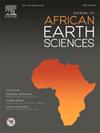修正反阿特拉斯带埃迪卡拉纪演替的岩石地层格架:西非克拉通卡多米亚地区对比
IF 2.2
4区 地球科学
Q2 GEOSCIENCES, MULTIDISCIPLINARY
引用次数: 0
摘要
在西非克拉通(WAC)的北缘,埃迪卡拉系地体在西欧的Meseta和Ossa-Morena带的反阿特拉斯和冈瓦南附近地体中生长。在后者,大约640-530 Ma Cadomian的演化被很好地理解,而影响摩洛哥地形的地球动力学事件仍然存在争议,部分原因是不精确的岩石地层单位及其年龄。在这项研究中,我们将新的野外调查与现有的地质年代学和同位素数据相结合,以完善Anti-Atlas的岩石地层学,并与Meseta和Ossa Morena带(西班牙)建立跨造山带对比。岩石地层修正表明,反阿特拉斯埃迪卡拉纪演替可划分为早埃迪卡拉纪Saghro群(640 ~ 600 Ma)和晚埃迪卡拉纪Ouarzazate超群(580 ~ 538 Ma),中间隔着一个2000万年(Ma)的沉积间隙。瓦尔扎扎特超群可进一步划分为M'Gouna、Lower Ouarzazate和Upper Ouarzazate 3组,每组具有不同的同位素特征,并被两个角不整合分隔开。这种新的岩石地层格架表明,东-中反阿特拉斯(ECAA)和梅塞塔(Meseta)保存了早埃迪卡拉世沉积和火山-深部充填的沉降弧后盆地,发育于640 - 600 Ma之间。这种早埃迪卡拉纪弧后序列在奥萨莫雷纳带也存在,但在西反阿特拉斯地区不存在,该时期构造保持稳定。该盆地的闭合以构造变质和岩浆活动为标志,主要表现为ECAA和Meseta的Saghro群和Ossa Morena的Montemolín组的变形,并伴有高Sr/Y特征的埃达质和岩浆活动的侵位。在整个反阿特拉斯和梅塞塔地区,这一阶段之后分别出现了约10迈和20迈的岩浆和沉积间隙。在此之后,沉积转变为陆基环境,在580 ~ 570 Ma期间,M’gouna群沉积,沉积和岩浆岩的εNd值为负,表明西非克拉通(WAC)陆壳再循环。下Ouarzazate群(LOG, 569-567 Ma)沉积在整个Anti-Atlas和Meseta的约2 Ma,与向更年轻的岩浆源转移相一致。上瓦尔扎扎特群(UOG, 567-540 Ma)以沉积、表碎屑矿床为主,仅含幼岩浆。这一修正的岩石地层格架突出了CEAA、Meseta和Ossa-Morena带之间相似的演化历史,并揭示了卡多米亚造山运动对冈瓦纳大陆的影响。本文章由计算机程序翻译,如有差异,请以英文原文为准。
Revising the lithostratigraphic framework of the Ediacaran succession of the Anti-Atlas belt: correlation across the Cadomian domain of the West African Craton
In the northern margin of the West African Craton (WAC), Ediacaran terranes crop out in the Anti-Atlas and the peri-Gondwanan terranes of the Meseta and the Ossa-Morena Zone of Western Europe. In the latter, the ca. 640-530 Ma Cadomian evolution is well understood, whereas geodynamic events effected terranes in Morocco remain debated, partly due to imprecise lithostratigraphic units and their ages. In this study, we integrate new field surveys with available geochronological and isotopic data to refine the lithostratigraphy of the Anti-Atlas and establish an across-orogen correlation with the Meseta and the Ossa Morena Zone (Spain).
The lithostratigraphic revision suggests that the Ediacaran succession of the Anti-Atlas can be subdivided into the early Ediacaran Saghro Group (640–600 Ma) and the late Ediacaran Ouarzazate Supergroup (580–538 Ma), separated by a 20-million-year (Ma) sedimentary gap. The Ouarzazate Supergroup is further subdivided into three groups: M'Gouna, Lower Ouarzazate, and Upper Ouarzazate, each characterized by distinct isotopic signatures and separated by two angular unconformities.
This new lithostratigraphic framework shows that the Eastern-Central Anti-Atlas (ECAA) and Meseta preserve an early Ediacaran sedimentary and volcano-plutonic infill of a subsiding back-arc basin that developed between 640 and 600 Ma. This early Ediacaran back-arc succession is also present in Ossa Morena Zone but is absent in the western Anti-Atlas, which remained tectonically stable during this period. The closure of this basin was marked by tectonic-metamorphic and magmatic activity, as evidenced by the deformation of the Saghro Group in the ECAA and Meseta and the Montemolín Formation in Ossa Morena, accompanied by the emplacement of adakitic and magmatism with high Sr/Y signature. Throughout the Anti-Atlas and the Meseta area, this phase was followed by a magmatic and sedimentary gap of approximately 10 Myr and 20 Myr, respectively. After these hiatuses, sedimentation transitioned to a subaerial continental environment with deposition of the M'gouna Group between 580 and 570 Ma with sedimentary and magmatic rocks characterized by negative εNd values indicative of West African Craton (WAC) continental crust recycling. The Lower Ouarzazate Group (LOG, 569–567 Ma) was deposited over ∼2 Ma across the entire Anti-Atlas and Meseta, coinciding with a shift toward a more juvenile magma source. The Upper Ouarzazate Group (UOG, 567–540 Ma) is dominated by sedimentary, epiclastic deposits with exclusively juvenile magma.
This revised lithostratigraphic framework highlights a similar evolutionary history between the CEAA, Meseta, and Ossa-Morena Zone and sheds new light on the effects of the Cadomian orogeny on the Gondwana mainland.
求助全文
通过发布文献求助,成功后即可免费获取论文全文。
去求助
来源期刊

Journal of African Earth Sciences
地学-地球科学综合
CiteScore
4.70
自引率
4.30%
发文量
240
审稿时长
12 months
期刊介绍:
The Journal of African Earth Sciences sees itself as the prime geological journal for all aspects of the Earth Sciences about the African plate. Papers dealing with peripheral areas are welcome if they demonstrate a tight link with Africa.
The Journal publishes high quality, peer-reviewed scientific papers. It is devoted primarily to research papers but short communications relating to new developments of broad interest, reviews and book reviews will also be considered. Papers must have international appeal and should present work of more regional than local significance and dealing with well identified and justified scientific questions. Specialised technical papers, analytical or exploration reports must be avoided. Papers on applied geology should preferably be linked to such core disciplines and must be addressed to a more general geoscientific audience.
 求助内容:
求助内容: 应助结果提醒方式:
应助结果提醒方式:


